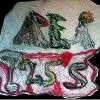The problem with betahistine is it's oral bioavaliability sucks - and the half-life is roughly 3 hours which means you would have to keep taking it every 3 hours, that's an inconvenient dosing schedule in my book. Although repeated administration may cause H(3) downregulation, it is called into question how positive of an effect this will be considering the body compensates for the excess NT's running through the CNS by upregulating alpha-2-receptor and imidazoline function.
H(3)R's also interact with D(1), D(2) and adenosine.
For example, taking Caffeine with BetaHistine over time, would result in a four-fold increase in D(2) receptor density, this is negative feedback to help lower the excessive cAMP levels and thyroid hormone that would pumped out by blocking PDE's and H(3)'s over time.
That all being said, H(3) blockers are under investigation for sleep-wake disorders and memory impairment, as well as dementia and depression.
Might wanna read some of my articles regarding this topic.
http://area1255.blog...mine-3-h3r.html
http://area1255.blog...t=1408892625677
http://area1255.blog...sturbing_5.html
Also should be worth pointing out that betahistine is NOT the only H(3)R blocker available.
There is an herbal remedy described in the first article there known as "YAMOA" which also contains H(3) blockers. It has antioxidant effects too.














































